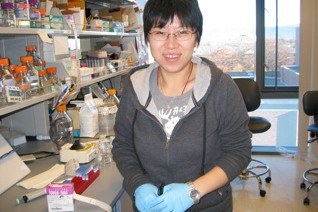
Zi Shi
by Zi Shi
The Arabidopsis thaliana NPR1 gene encodes a transcription factor (NPR1) that plays a major role in the mechanisms of plant defense response. After pathogen infection and in response to salicylic acid (SA) accumulation, NPR1 translocates from the cytoplasm into the nucleus where it interacts with other transcription factors resulting in the activation of over 100 plant defense genes contributing to a pathogen resistance response. A putative Theobroma cacao NPR1 cDNA was isolated by RT-PCT using degenerate primers based on homologous sequences from Brassica, Arabidopsis and Papaya. The cDNA was used to isolate a genomic DNA clone containing a putative TcNPR1 gene. DNA sequencing revealed the presence of a 4.5 kb coding region containing three introns and encoding a polypeptide of 591 amino acids. The predicted TcNPR1 protein shares 55% identify and 78% similarity to Arabidopsis NPR1, and contains each of the highly conserved functional domains indicative of this class of transcription factors (BTB/POZ and ankyrin protein-protein interaction domains and a Nuclear Localization Sequence (NLS)). A second NPR1-like gene was also identified, TcNPR3. To functionally define the TcNPR1 gene, we performed functional complementation analysis using an Arabidopsis npr1 null mutant that is highly susceptible to infection by the plant pathogen Psuedomonas syringae. Driven by the constitutive CaMV35S promoter, the cacao TcNPR1 gene partially complimented the npr1 mutation in transgenic Arabidopsis plants, resulting in 100 fold less bacterial growth in a leaf infection assay. Upon induction with SA, TcNPR1 was shown to translocated into the nucleus of leaf and root cells in a manner identical to Arabidopsis NPR1. We conclude that the cacao TcNPR1 gene we have characterized is the true functional ortholog of Arabidopsis NPR1, and is likely to play a major role in defense response in cacao. Further details of this research will be presented. This fundamental knowledge can contribute to breeding of disease resistant cacao varieties through the application of molecular markers or the use of transgenic strategies.

